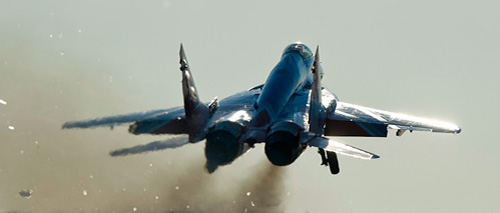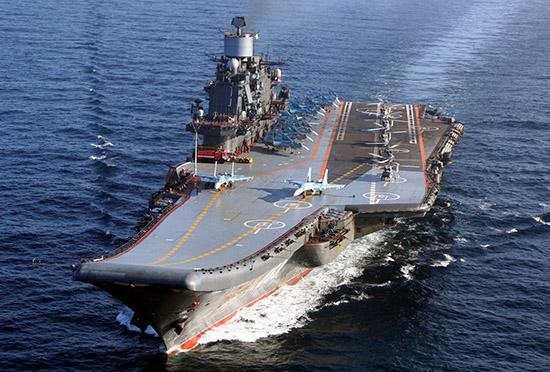The Russian aircraft carrier Admiral Kuznetsov will be in battle against the Islamic State for four months starting next October. The flight activities will continue until January of next year, the carrier will be operational with its relative battle group from the Eastern Mediterranean. This is what they say from Moscow to the official Russian news agency Tass.
The note reads: "The General Staff has set up a plan to operate the carrier in the Syrian Arab Republic".
From the Kremlin they note that the Kuznetsov will be deployed not far from the Syrian coast, so as to allow the airborne group to complete all scheduled military activities. The flight crew of the Russian aircraft carrier will coordinate with the air force stationed at the Hmeymim base.
The Russian General Staff also reveals the number of aircraft on the carrier: 15 hunts between Su-33 and MiG-29K / KUB (photo) and ten helicopters Ka-52K, Ka-27 and Ka-31. The future boarded air group of the Russian aircraft carrier Admiral Kuznetsov, last week officially concluded his ground training period at Novofedrorovka's licensing facility. Pilots conducted more than 150 takeoffs and landings on both the Su-25UTG training platforms and the Su-33 multi-role fighters. It is the first time that the training center is used after updates on regulatory and certification operations. The training center in the Crimea has been unique for the North Fleet pilots for years. A new training center was set up in Yeysk, in the Krasnodar area. In the coming months, the Yeysk base, on the bank of the Sea of Azov, will become the main enabling structure for Russian embarked air groups.
 After the patrolling in the Mediterranean, the Kuznetsov it will enter the construction site for reconstruction work on the entire flight deck, replacing the lining and the take-off and landing system. These interventions, set for the beginning of the 2017, will last three years. The aircraft carrier is currently being trained in the Barents Sea after repairs at the 82 shipyard in Roslyakovo, in the Murmansk region. THE'Admiral Kuznetsov it has undergone work on the electro-mechanical apparatus and some components of the ship's transmission have been replaced. The heavy missile rocket cruiser uses the Short Take Off But Arrested Recovery or STOBAR system to take off and land the aircraft.
After the patrolling in the Mediterranean, the Kuznetsov it will enter the construction site for reconstruction work on the entire flight deck, replacing the lining and the take-off and landing system. These interventions, set for the beginning of the 2017, will last three years. The aircraft carrier is currently being trained in the Barents Sea after repairs at the 82 shipyard in Roslyakovo, in the Murmansk region. THE'Admiral Kuznetsov it has undergone work on the electro-mechanical apparatus and some components of the ship's transmission have been replaced. The heavy missile rocket cruiser uses the Short Take Off But Arrested Recovery or STOBAR system to take off and land the aircraft.
Built at the South Mykolaiv Shipyard (today Ukraine) in the mid-'80, theAdmiral Kuznetsov it became fully operational only in the 1995, due to the drastic cuts in the budget of the Russian Defense following the collapse of the Soviet Union. The ship, designed to hit large surface targets and protect sea lanes from enemy attacks, is capable of carrying a maximum of 52 fixed and rotating wing aircraft and the only one in the world that can operate even at polar latitudes. The airborne group includes Su-25 UTG, Su-33 (Flanker-D), MiG-29K / KUB and Ka-27 and Ka-29 helicopters.
Although designed to operate independently, the sea return of the Admiral Kuznetsov will receive special attention from the Russian Admiralty for the preparation of his carrier battle group. Discounted presence of at least two destroyers of the class Sovremenny ed Udaloy, in an event of power (and undoubted charm), the Kremlin could opt to grant the Kuznetsov the battle group of the heavy rocket-powered missile cruiser Pyotr Veliky, flagship of the Northern Fleet. At sea since last May after two years of modernization work, he is normally escorted by five destroyers. The last trip of the Pyotr Veliky dates back to January 2014, during an exercise in the Mediterranean. At that juncture, he remained in business for seven months.
 Il Pyotr Veliky it is the world's largest nuclear-powered warship, equipped with anti-ship missiles Turkish Granite and defense strong, naval version of the S-300. In 2019, the heavy cruiser will re-enter the shipyard for further action aimed at the implementation of hypersonic missiles Tsirkon. The first patrol with hypersonic missiles should take place within the 2022.
Il Pyotr Veliky it is the world's largest nuclear-powered warship, equipped with anti-ship missiles Turkish Granite and defense strong, naval version of the S-300. In 2019, the heavy cruiser will re-enter the shipyard for further action aimed at the implementation of hypersonic missiles Tsirkon. The first patrol with hypersonic missiles should take place within the 2022.
Nuclear-class battle missile cruisers Kirov they are the most beautiful ships of the Soviet era. Four were built (only one is active, two "should" be put back into service within the 2020, while the fourth was demolished) and represent the maximum Soviet expression of the frontline battle ships. Their armament is so heavy that there is no Western equivalent to them. It would be correct to state that the class Kirov for conception and power it is a middle way between classes Ticonderoga and Iowa American.
The heavy armament of the Kirov includes, as the main end, twenty SS-N-19 missiles Shipwreck. We are talking about an armored antineve missile, weighing seven tons, ten meters long and with a range of 700 km. If launched to swarm, missiles can interact with each other by prioritizing. The Shipwreck equip the Kirov, Admiral Kuznecov and the nuclear attack submarines class Oscar-II, designed specifically for the role of Carrier Killer. Considering the presence in the Mediterranean in the shift of the class cruisers Glory, the choice of Pyotr Veliky and its battle group could be the best for a variety of reasons.
Lastly, the presence of an attack submarine, probably a Varshavyanka, from the Black Sea Fleet.
(photo: MoD Russian Federation)












